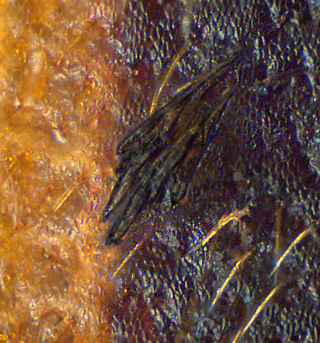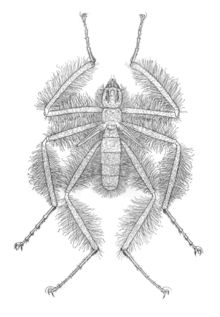
Kitti's hog-nosed bat, also known as the bumblebee bat, is a near-threatened species of bat and the only extant member of the family Craseonycteridae. It occurs in western Thailand and southeast Myanmar, where it occupies limestone caves along rivers.

Calyptratae is a subsection of Schizophora in the insect order Diptera, commonly referred to as the calyptrate muscoids. It consists of those flies which possess a calypter that covers the halteres, among which are some of the most familiar of all flies, such as the house fly.

Hippoboscoidea is a superfamily of the Calyptratae. The flies in this superfamily are blood-feeding obligate parasites of their hosts. Four families are often placed here:

Cephalotus is a genus which contains one species, Cephalotus follicularis the Albany pitcher plant, a small carnivorous pitcher plant. The pit-fall traps of the modified leaves have inspired the common names for this plant, which also include Western Australian pitcher plant, Australian pitcher plant, or fly-catcher plant. It is an evergreen herb that is endemic to peaty swamps in the southwestern corner of Western Australia. As with the unrelated Nepenthes, it catches its victims with pitfall traps.

Nycteribiidae is a family of the true fly superfamily Hippoboscoidea. Together with their close relatives the Streblidae, they are known as "bat flies". As the latter do not seem to be a monophyletic group, it is conceivable that bat flies cannot be united into a single family.

The Curtotonidae or quasimodo flies are a small family of small grey to dark brown humpbacked flies (Diptera) with a worldwide distribution, but with very few species in the Nearctic, Australasian/Oceanian, and Palaearctic regions. Most members of the family are found in tropical to subtropical latitudes in Africa and the Neotropics. Many remain undescribed in collections, since little work on the family has been done since the 1930s.

Chyromyidae are small to very small cyclorrhaphous, acalyptrate flies (Diptera) currently classified within the Heleomyzoidea by most authors. The majority have a pale yellow integument and bright iridescent green, red or purple eyes. The family is represented in all continents except Antarctica. There are about 150 named species in this family worldwide. There has been no comprehensive taxonomic study to elucidate the generic limits of species in the family. Currently, only four genera are recognised, but ongoing studies of the African species indicate that there are more.

The fawn leaf-nosed bat is a species of bat in the family Hipposideridae found in Australia, Indonesia, Malaysia, the Philippines and Vanuatu.

Decken's horseshoe bat is a species of horseshoe bat. It is found in Kenya and Tanzania. Its natural habitats are tropica and subtropical moist lowland and montane forest, moist savanna, caves and other subterranean habitats.

Laboulbenia is a genus of fungi in the family Laboulbeniaceae.
Urodolichus is a genus of fly in the family Dolichopodidae. It is known from the Afrotropical realm, Indomalayan realm and Australasian realm. It has been placed in either Rhaphiinae or Diaphorinae, though Grichanov & Brooks (2017) consider the genus to be incertae sedis within the family Dolichopodidae.

Thyreophora cynophila, commonly known as the bone skipper is a species of fly native to Europe. It was once thought to be the first fly to be driven to extinction by humans, but rediscovered in 2009. It has a bright orange head, and is associated with animal carcasses where the bones are broken open.

The Alcathoe bat is a European bat in the genus Myotis. Known only from Greece and Hungary when it was first described in 2001, its known distribution has since expanded as far as Portugal, England, Sweden, and Russia. It is similar to the whiskered bat and other species and is difficult to distinguish from them. However, its brown fur is distinctive and it is clearly different in characters of its karyotype and DNA sequences. It is most closely related to Myotis hyrcanicus from Iran, but otherwise has no close relatives.
Cicurina madla is a rare species of spider in the family Dictynidae known by the common name Madla Cave meshweaver. It is endemic to Texas, United States, where it is known to originate from only eight or nine caves in Bexar County. This is one of a small number of invertebrates endemic to the karst caves of Bexar County that were federally listed as endangered species in the year 2000. Another spider from the caves was described as Cicurina venii, and given the common name Braken Bat Cave meshweaver. In 2018, it was synonymized with C. madla.
Afrosyrphus is an African genus of hoverfly. They mimic stingless bees, having long, upward pointing antennae and hairy hind legs. Larvae feed on aphids.
Brian Roy Stuckenberg was a South African entomologist who specialised in Diptera.

Peripatopsis alba, the white cave velvet worm, is a species of velvet worm in the family Peripatopsidae. This species is notable as one of only two species of velvet worm known to be troglobitic; the only other velvet worm known to be a troglobiont is Speleoperipatus spelaeus. The white cave velvet worm is rare and limited to one cave system on Table Mountain in South Africa.
Alhajarmyia is a genus of wormlion in the family Vermileonidae. It consists of two species from the Arabian Peninsula and East Africa. It is closely related to the Malagasy endemic Isalomyia.
Isalomyia is a genus of wormlion in the family Vermileonidae. It contains a single species Isalomyia irwini, endemic to Madagascar. It is closedly related to Alhajarmyia, a genus from the Arabian Peninsula and East Africa.
The sandy long-fingered bat, also known as the sandy bent-winged bat, is a species of bat from the genus Miniopterus that is endemic to the Arabian Peninsula and East Africa. The species was initially described as a subspecies of either M. schreibersii or M. natalensis. Recent genetic research has revealed that specimens from the Arabian Peninsula and Ethiopia, which were tentatively ascribed to the genus, are significantly distinct from M. schreibersii and M. natalensis. A genetic analysis of type locality material is still needed before taxonomy can be resolved.













